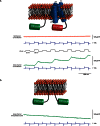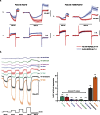Pado, a fluorescent protein with proton channel activity can optically monitor membrane potential, intracellular pH, and map gap junctions
- PMID: 27040905
- PMCID: PMC4878010
- DOI: 10.1038/srep23865
Pado, a fluorescent protein with proton channel activity can optically monitor membrane potential, intracellular pH, and map gap junctions
Abstract
An in silico search strategy was developed to identify potential voltage-sensing domains (VSD) for the development of genetically encoded voltage indicators (GEVIs). Using a conserved charge distribution in the S2 α-helix, a single in silico search yielded most voltage-sensing proteins including voltage-gated potassium channels, voltage-gated calcium channels, voltage-gated sodium channels, voltage-gated proton channels, and voltage-sensing phosphatases from organisms ranging from mammals to bacteria and plants. A GEVI utilizing the VSD from a voltage-gated proton channel identified from that search was able to optically report changes in membrane potential. In addition this sensor was capable of manipulating the internal pH while simultaneously reporting that change optically since it maintains the voltage-gated proton channel activity of the VSD. Biophysical characterization of this GEVI, Pado, demonstrated that the voltage-dependent signal was distinct from the pH-dependent signal and was dependent on the movement of the S4 α-helix. Further investigation into the mechanism of the voltage-dependent optical signal revealed that inhibiting the dimerization of the fluorescent protein greatly reduced the optical signal. Dimerization of the FP thereby enabled the movement of the S4 α-helix to mediate a fluorescent response.
Conflict of interest statement
The authors declare no competing financial interests.
Figures







Similar articles
-
Combinatorial mutagenesis of the voltage-sensing domain enables the optical resolution of action potentials firing at 60 Hz by a genetically encoded fluorescent sensor of membrane potential.J Neurosci. 2015 Jan 7;35(1):372-85. doi: 10.1523/JNEUROSCI.3008-14.2015. J Neurosci. 2015. PMID: 25568129 Free PMC article.
-
Single-molecule fluorimetry and gating currents inspire an improved optical voltage indicator.Elife. 2015 Nov 24;4:e10482. doi: 10.7554/eLife.10482. Elife. 2015. PMID: 26599732 Free PMC article.
-
A voltage sensor-domain protein is a voltage-gated proton channel.Science. 2006 Apr 28;312(5773):589-92. doi: 10.1126/science.1122352. Epub 2006 Mar 23. Science. 2006. PMID: 16556803
-
Voltage-gated proton (H(v)1) channels, a singular voltage sensing domain.FEBS Lett. 2015 Nov 14;589(22):3471-8. doi: 10.1016/j.febslet.2015.08.003. Epub 2015 Aug 18. FEBS Lett. 2015. PMID: 26296320 Review.
-
Optical consequences of a genetically-encoded voltage indicator with a pH sensitive fluorescent protein.Neurosci Res. 2019 Sep;146:13-21. doi: 10.1016/j.neures.2018.10.006. Epub 2018 Oct 18. Neurosci Res. 2019. PMID: 30342069 Free PMC article. Review.
Cited by
-
Improving a genetically encoded voltage indicator by modifying the cytoplasmic charge composition.Sci Rep. 2017 Aug 15;7(1):8286. doi: 10.1038/s41598-017-08731-2. Sci Rep. 2017. PMID: 28811673 Free PMC article.
-
Deciphering the molecular mechanism responsible for GCaMP6m's Ca2+-dependent change in fluorescence.PLoS One. 2017 Feb 9;12(2):e0170934. doi: 10.1371/journal.pone.0170934. eCollection 2017. PLoS One. 2017. PMID: 28182677 Free PMC article.
-
Gap Junctions in the Nervous System: Probing Functional Connections Using New Imaging Approaches.Front Cell Neurosci. 2018 Sep 19;12:320. doi: 10.3389/fncel.2018.00320. eCollection 2018. Front Cell Neurosci. 2018. PMID: 30283305 Free PMC article. Review.
-
Biophysical Parameters of GEVIs: Considerations for Imaging Voltage.Biophys J. 2020 Jul 7;119(1):1-8. doi: 10.1016/j.bpj.2020.05.019. Epub 2020 May 29. Biophys J. 2020. PMID: 32521239 Free PMC article. Review.
-
Mechanism of ArcLight derived GEVIs involves electrostatic interactions that can affect proton wires.Biophys J. 2021 May 18;120(10):1916-1926. doi: 10.1016/j.bpj.2021.03.009. Epub 2021 Mar 17. Biophys J. 2021. PMID: 33744263 Free PMC article.
References
Publication types
MeSH terms
Substances
LinkOut - more resources
Full Text Sources
Other Literature Sources
Research Materials
Miscellaneous

